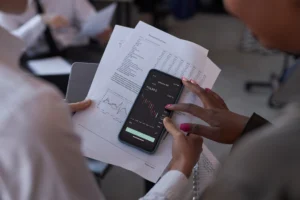Slippage trading is a reality every forex trader encounters sooner or later. Whether you are a beginner taking your first trades or a seasoned professional managing large positions, the effect of slippage can appear suddenly and shake your confidence. It often happens when the market moves faster than expected, leaving your order executed at a different price than planned. For many traders, this small shift feels insignificant at first, yet it can quietly undermine even the most carefully designed strategies.
Most traders spend countless hours studying technical analysis, identifying chart patterns, or reacting to economic news releases. While these factors are important, they often overlook one of the most critical pieces of trading success: how orders are actually executed. Poor attention to execution can create a hidden leak in your trading system, and slippage is often the culprit.
If you are serious about consistent results, understanding slippage in trading is non-negotiable. You need to know what it really means, why it occurs, and in which market conditions it strikes hardest. Equally important, you must learn how to avoid slippage whenever possible—or at least minimise its damage when it is inevitable. Slippage may look like a minor inconvenience, but repeated often enough, it can eat into your profits, distort your risk management, and even turn a winning system into a losing one.
In the sections ahead, we will explore every aspect of slippage trading in detail, from the conditions that trigger it to the strategies that can help you manage it effectively. With the right awareness and preparation, you can protect your trading edge and make sure execution risk does not stand between you and long-term success.
What Is Slippage in Trading?
Slippage in trading happens when your trade is filled at a different price than the one you requested. This is a simple concept, but its impact is huge. Imagine you want to buy EUR/USD at 1.1200, but when the order executes, you receive 1.1206. That six-pip difference is slippage. If you trade with leverage or use large position sizes, even a small slip can translate into a real financial impact.
Slippage trading is not just a one-off problem. It is built into every moment you spend in the market. Prices can move in milliseconds. If you are trading during a volatile event or when the market is thin, your risk of slippage increases. Every time you use a market order, you accept that you may not get the price you see on your screen. This is why professional traders always ask what slippage is in trading and how they can avoid slippage before risking real money.
Positive slippage does exist. Sometimes the market moves in your favour between the time you send the order and the time it executes. However, negative slippage is much more common and usually hurts your results. This is especially true in forex, where prices react instantly to global news and economic releases.
Why Does Slippage Happen?
Market volatility is the leading cause of slippage trading. When big news breaks or unexpected economic numbers are released, prices can jump in a second. Your order joins a long queue of others, and the price may change before you reach the front of the line. Liquidity is also a factor. If you trade exotic currency pairs or during off-peak hours, there may not be enough buyers and sellers to fill your order at your price. When the market is quiet, the spread can widen, and your order may get filled at the next available price.
Order type is another important consideration. Market orders give you the fastest entry but no guarantee on price. Limit orders allow you to set your price, but you may miss the trade if the market never touches your level. Both choices have advantages and risks. This is why your understanding of forex order execution must include both types of orders and how they behave in different market conditions.
Broker technology can play a big role. Some brokers have faster execution speeds and deeper liquidity pools. Others may have slower servers or less access to liquidity, which increases the risk of a bad trading slippage example. Experienced traders spend time testing brokers, comparing fill prices, and looking for signs that their broker delivers what it promises.
The Impact of Slippage on Your Trading Results
Slippage trading can have a huge impact on your results, especially over time. It is easy to ignore a pip or two lost here and there, but those small losses add up fast. Suppose you trade actively and lose two pips per trade to slippage. After 100 trades, you are down 200 pips—often enough to erase your month’s profits.
Risk management becomes more difficult when you have to factor in slippage. If you plan to risk ten pips but consistently lose an extra three pips to slippage, your true risk is now 13 pips per trade. Your calculations for position size and stop loss need to reflect this reality. If you don’t adjust, you may take on more risk than you intended. This can shake your confidence, lead to emotional decisions, or cause you to abandon good strategies.
Slippage also distorts your win rate. Many scalpers, who depend on small moves for profit, find that slippage trading turns a winning approach into a losing one. Even if you win 55% of your trades, if each loss is larger than expected because of slippage, you could still lose money overall. Every trading slippage example is a reminder that the market is full of moving parts you cannot control.
Your trading psychology is also affected. After a few trades where slippage starts you off at a disadvantage, frustration can build. You may start to second-guess your approach or take impulsive trades to “make back” what you lost. The best traders learn to accept slippage trading as part of the environment. They focus on planning, adapting, and keeping their emotions in check.
Real-Life Slippage Trading Example
Let’s say you trade GBP/USD during a major central bank announcement. You plan to buy at 1.2950 and press buy as soon as the news is released. The market surges, and by the time your order is filled, you receive 1.2965. That 15-pip difference can change a low-risk entry into an immediate loss. If your stop loss is only 20 pips, most of your risk is gone before the trade even gets going. This trading slippage example is common around economic releases, and every trader needs to factor it into their plan.
Stop losses are also vulnerable to slippage. Suppose you set a stop at 1.2100, but the market drops suddenly and your fill is at 1.2090. You lose more than planned. In some cases, especially during flash crashes or illiquid periods, the price can move far from your stop, causing a much larger loss. Traders with experience know to avoid slippage by staying out of the market during the most unpredictable times or by widening stops when necessary.
How to Avoid Slippage in Forex
While you cannot eliminate slippage trading completely, you can reduce its impact with smart trading practices and disciplined execution. One of the most effective ways is to trade during periods of high liquidity. The London and New York sessions are considered the busiest times, and their overlap offers the deepest pools of buyers and sellers. With so much activity, prices move quickly, but orders are usually filled more accurately, reducing the risk of unexpected gaps.
Another practical step is using limit orders whenever possible. Limit orders ensure that your trade will not be executed at a worse price than requested. While this means your order may sometimes remain unfilled, it protects you from sudden jumps that occur with market orders. Market orders provide instant entry but come with no guarantee against slippage.
Timing is also critical. Avoid trading during major news releases, central bank announcements, or unexpected geopolitical events. During these moments, price action can become extremely volatile, and your forex order execution may struggle to keep up. Many traders prefer to wait for the initial chaos to settle before entering trades.
Choosing a reliable broker is equally important. Test several brokers on demo or with small live accounts, and compare the quoted price with the actual fill. Ask about execution speed, slippage policies, and whether you can set maximum slippage tolerances.
Finally, keep a trading journal. Record your intended price, the actual fill, the currency pair, the session, and the market conditions. Over time, you will see patterns—such as slippage being worse on certain pairs or sessions. This knowledge allows you to adjust your strategy and protect your edge.
Forex Order Execution Explained
Forex order execution refers to the process of filling your buy or sell order at the best available price in the market. The quality of this process depends on several factors, including your broker’s technology, the liquidity providers they connect to, and overall market conditions at the time you place the trade.
Execution speed is one of the most critical elements. In a fast-moving forex market, even a delay of a few seconds can change your entry price significantly. A perfect setup can turn into an unexpected slip if your broker cannot process the order quickly. This is why many traders regularly test their broker’s execution quality and compare advertised prices with the actual fills they receive.
Broker type also makes a difference. ECN (Electronic Communication Network) brokers route your orders directly to banks, hedge funds, and other traders, matching you with real market participants. This model often provides tighter spreads and reduces slippage because it relies on genuine market liquidity. On the other hand, market maker brokers may fill your trades from their internal book. While this can sometimes mean faster fills, thin internal liquidity may increase the chances of slippage.
It is also worth understanding the role of liquidity. During active trading sessions, execution tends to be smooth and accurate because there are plenty of counterparties. However, in low-volume periods such as late Fridays or during holidays, even small orders may slip.
Ultimately, mastering forex order execution means staying aware of how your broker operates, regularly monitoring trade fills, and aligning your strategy with market conditions. Traders who respect execution as much as analysis are more likely to maintain consistency in their results.
Advanced Strategies for Managing Slippage
Experienced traders often go beyond basic methods when dealing with slippage trading. Instead of placing one large order, they sometimes split their position into multiple smaller trades. This reduces the chance of a single order moving the market and triggering higher slippage. Another advanced tool is the depth-of-market (DOM) display, which allows traders to see how much liquidity exists at each price level. By understanding where buyers and sellers are concentrated, you can place smarter orders and minimise unexpected execution issues.
Algorithmic traders also play an important role in slippage management. They program their bots to factor in average slippage during both backtesting and live execution. This way, trading results are closer to real market conditions. Many advanced platforms also provide “slippage tolerance” features. These settings let you pre-define how much slippage you are willing to accept before an order is cancelled, giving you more control over execution.
Backtesting with slippage included is crucial. Traders who use automated systems or expert advisors often simulate realistic slippage values when testing strategies. Doing this prepares them for live trading, where perfect fills are rare. Without accounting for slippage, even the best-looking system may fail under real conditions. The key is to combine smart trade sizing, reliable tools, and realistic expectations to handle slippage like a professional.
Slippage and Your Trading Mindset
Slippage is not only a technical problem—it’s also a psychological challenge. Every trader, no matter how skilled, will experience it. The difference lies in how you respond. If you allow frustration to guide your decisions, small losses from slippage can turn into larger mistakes. The right approach is to accept that slippage is part of the trading environment and treat it as another cost of doing business.
Each trading slippage example provides valuable feedback. Instead of getting upset, study your fills and ask why they occurred. Was it low liquidity, poor timing, or a broker issue? Reviewing these details in your trading journal helps you adapt your methods. Some traders find that slippage always spikes on certain pairs, during specific sessions, or around news events. Identifying these patterns gives you the power to avoid the worst conditions.
Maintaining composure is critical. If you notice slippage is hurting your performance, pause and reassess. Adjust your trading times, refine your order types, or even change brokers if necessary. By staying calm, focused, and analytical, you prevent emotions from controlling your actions. The best traders accept slippage as part of the game while continuously improving how they manage it.
Slippage in Other Markets
Although slippage is a frequent challenge in forex, it appears across all markets—stocks, futures, and crypto included. In stocks, slippage often happens when there is low liquidity or when a sudden surge in demand causes orders to fill at different levels. A few cents of slippage might seem small, but it can add up when trading large volumes.
In futures trading, slippage can occur during market openings or after major announcements. Gaps between closing and opening prices are especially common, leaving traders with fills far from their intended entry. The leveraged nature of futures trading can magnify this impact, making slippage management essential.
Crypto markets are perhaps the most notorious for slippage. With their wide spreads, sudden volatility, and sometimes thin liquidity, crypto traders often face extreme differences between requested and executed prices. For this reason, many crypto exchanges also offer slippage tolerance tools.
The common thread across all markets is the same: order execution matters. By planning for slippage, using the right tools, and understanding market-specific risks, traders can reduce surprises and strengthen their strategies.
Bringing It All Together
Slippage trading may be unavoidable, but it doesn’t have to control your results. With proper planning and discipline, you can manage its impact. Always prioritise high-liquidity sessions such as the London and New York overlaps, use limit orders where possible, and avoid chaotic news-driven volatility. Choosing brokers who offer fast and transparent forex order execution also makes a major difference.
Your trading journal is your secret weapon. By recording every detail—requested price, executed price, pair, and conditions—you gain insights that allow you to adjust your approach. Over time, these notes help you identify when and where slippage occurs most often, giving you the ability to sidestep its worst effects.
So, what is slippage in trading? Simply put, it’s the difference between the price you expect and the price you actually receive. How do you avoid slippage? You trade smart, stay disciplined, and treat every slippage example as an opportunity to grow. With practice and patience, you’ll not only minimise losses but also build greater confidence, consistency, and long-term control in your trading journey.
Read here to learn more about “Backtesting Explained: Simple Steps and Common Risks“.

I’m Chaitali Sethi — a seasoned financial writer and strategist specializing in Forex trading, market behavior, and trader psychology. With a deep understanding of global markets and economic trends, I simplify complex financial concepts into clear, actionable insights that empower traders at every level. Whether it’s dissecting winning strategies, breaking down market sentiment, or helping traders build the right mindset, my content bridges the gap between information and implementation.




